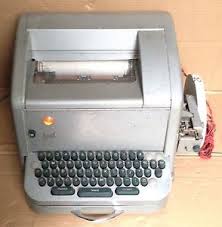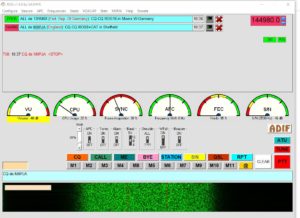How to Get Started with Amateur Radio Data with some of the traditional Data Modes
How to Get Started with Data Modes
Amateur radio data modes have a lot to offer, they are a fascinating part of the Amateur Radio hobby, and are definitely worth considering
Here’s some advice to get you started, in operating the amateur radio digital modes.
Why Should I try data modes?:
- Data tends to work well with low-power
More bandwidth-friendly than voice
Electronic logging is often made very easy with Amateur radio data modes
Helpful if you have a hearing issue
There are Fun!
Getting started with Amateur Radio data modes:
Here’s a list of what you may need to get started with amateur radio data modes:
• An Interface – On radios like the Kenwood TS-590 and Icom IC-7100 a data interface is built-in and they usually come with a USB Cable
• Cables to connect between the computer, radio and the Interface
• A computer with a soundcard (mic and speaker sockets) – We would recommend getting a small additional soundcard
• Time Source – it’s important to keep your time accurate
• Software – See below
• The right frequencies – out the band plan for the dedicated frequency for each band
A Data Interface (if required)
The Data Interface is the device that connects between your radio and the computer.
Some radios already have these built-in – Check your Documentation or ask another Radio Amateur
We recommend ZLP Electronics – you can visit their website here.
You need to make sure you get the correct interface. Here’s what you need to know:
• PTT – (Push to Talk) This method that your computer can use the Interface to get your radio to transmit
CAT – (Computer Aided Tuning) This allows a computer to control/change the frequencies and some settings on your radio
• DATA – Your Interface needs to be able to handle data transfer between the radio and computer. It also needs to support the baud rate used by the ports and or by the amateur radio data mode in question
• CW –This is handy if you are looking to use your computer to send and receive CW, ask if your Interface supports CW (check the documentation)
• Connectivity – Make sure that your Interface is suitable to connect to your radio, and get the correct leads also ask what will happen if I change the radio
Getting the Audio Correct
It’s very important not to overdrive your radio. Your soundcard can do a lot of the work, with radios like the Icom 7100 check settings can also be adjusted on the Radio, check your radio documentation to be successful when working data modes are important to get the audio levels to and from the computer Adjusted correctly.
Don’t forget that you will need to adjust both the input and output levels on your system to get the levels right. On a Windows PC, you can use the device manager to see which sound card to use. If your radio or Interface contains a sound card just remove it and plug it back in should show you which one it is.
On a Linux system aplay -l from the cmd line should list the sound card or you can have a look at dmesg (also useful for finding the ports).
Set your Clock up Correctly
• Keep your PC clock in sync with Dimension 4
• If running Linux use NTP or chrony.
WSJT-X
To start with try WSPR (Weak Signal Propagation Reporter) and download the WSJT-X software program
With WSPR you can send and receive data. You send out, over the course of a minute, a data signal containing your location and callsign, and can then check online which stations received your signal check out http://wsprnet.org/drupal/wsprnet/activity
Want to give WSPR and WSJT-X a try? See https://www.youtube.com/watch?v=QrKWlhvYop8&t=4s
JT65 / JT9/FT8/FT4
These modes are similar to WSPR, and they come with the WSJT-X Software, However, and allow a QSO-type exchange. In order to avoid splatter with and interfere with other transmissions, we recommend that you keep the power low (max 20 watts) will be sufficient.
These modes allow sending short messages. With JT65, each “over” takes one minute. The newer FT4 is faster and FT8 and FT8 have taken over the top slot in amateur radio data modes
For Example, messages are typically 13 characters long, and go something like this: “CQ with location, Reply with location, RST, RST, Report Received, 73, 73”
PSK31
Stands for Phase Shift Keying with a bandwidth of 31.25Hz. IT was developed and named by Radio Amateur called Peter Martinez (call sign G3PLX) and introduced to the amateur radio community in December 1998. This allows a two-way QSO and typically uses macros for common phrases.
Software for PSK:
Ham Radio Delux the New Versions are paid for, however, if you have a Google around you may be able to find a copy of the last free version
MixW – a nice connection of data modes supported last updated in 2017, well worth a look at
FLDigi – Runs on both Windows and Linux, has been called “the Swiss army knife of data software”
Airlink Express – great works very well on Windows 7 & 10.
Wolphi Link – sell a data interface that will link to your Android phone* and you can download DroidPSK from the Play Store.
RTTY
This stands for Radio Teletype, and in the good old days you would have used something like a creed teletype (see below) and this was nothing like the smell of hot oil and ink (trust me ? ) this mode supports two-way QSOs – you can type in real-time, of use macros and your message is displayed at the other station almost instantly. These days it is all software-driven.
Software:
Ham Radio Delux (HRD
Older but still good MMTTY
MixW
FLDigi
Airlink Express
Wolphi – DroidRTTY
A Creed TeleType Machine

SSTV or Slow Scan
Send and receive images. Formats include Robot / Scottie/ Martin/ PD120. (The ISS uses PD120 (See Below) Images use around 3kHz of bandwidth and take a few minutes to download.
Software:
HRD
MixW
FLDigi
MMSSTV (getting a bit old now)
QSSTV in Linux (works very very well)
Wolphi link DroidSSTV
Robot32 in Android
Black Cat System Software on iPhone
APRS
APRS packet data is sent in short bursts at 1200 Baud. APRS is (Automatic Packet Reporting System). You used to need a TNC (Terminal Node Controller) to send and receive packet data. However, you can use programs like Direwolf and platforms like the Raspberry PI, Arduino, and RTL-SDR.
If you tune your radio to 144.800MHz*, you should hear APRS packets containing status messages, locations and weather information.
Software: Direwolf, YAAC, UIView APRSDroid for your Android phone
• To check out Radio amateurs locally, open the map at www.aprs.fi
Remember that we have an APRS I-GATEway at the Radio Society, Paul M0PJA is a good person to talk to you about APRS
A small neat little TNC that works with a Baofeng and other radios is made by Mobilinkd, you can also get details of an Open Source Arduino based project to make your own TNC (shown here with a Wouxun)
APRS and the ISS
You can send and receive APRS packets from the ISS. To do this, you’ll need to be set up for APRS. These links will help too. If you’re interested, we can create a more detailed explanation of how to work ISS in packet mode.
• You are able to check when the ISS is in line-of-site using Amsats free AmsatDroid or www.isstracker.com or Orbitron software – gpredict works well on Linux.
• Check if the ISS Packet is active here: www.issfanclub.com
• You can check if your packet was relayed at www.ariss.net
• Send and receive APRS packets with YAAC or UI-View software
For Packet related info see https://www.ariss.org/contact-the-iss.html#Packet
For General information on Amateur Radio and the ISS see https://www.ariss.org/
ROS
 ROS is a weak signal mode written by EA5HVK, It is great mode to use and it makes the most of amateur radio and the Internet, please note that some of the frequencies set up in the Program are outside the Amateur Radio Bands. You should check the band plan for your Region before using this software.
ROS is a weak signal mode written by EA5HVK, It is great mode to use and it makes the most of amateur radio and the Internet, please note that some of the frequencies set up in the Program are outside the Amateur Radio Bands. You should check the band plan for your Region before using this software.
You can use macros and hand type in a message, ROS has excellent documentation in a number of languages, as its developer is from Spain, its more European focused however please don’t let that put you off.
There is a very good YouTube video at https://www.youtube.com/watch?v=3KBgqU8dL9c by VE1XOP, there are a number of people in the Radio Society who use this mode. If you want more info both Paul G8NRY and Paul M0PJA are good sources of information
The software can be downloaded from https://rosmodem.wordpress.com/
JS8CALL
JS8CALL is Amateur Radio software using the JS8 Digital Mode providing weak signal keyboard-to-keyboard messaging to Amateur Radio Operators
It has become very popular with members of the prepper community. JS8Call is a derivative of the WSJT-X software application (see above), restructured and redesigned for passing messages passing using a custom FT8 modulation called JS8. Please note that it is not supported nor endorsed by the WSJT-X development group. While the WSJT-X group maintains copyright over the original work and code, JS8Call is a derivative work licensed under and in accordance with the terms of the GPLv3 license.
If you already have WSJT-X working you can use the same configuration to setup JS8CALL, there are a number of good YouTube videos and there are excellent guides on the website at http://js8call.com/guides/
A number of members of the Radio Society run JS8CALL, which can run on Windows, Linux and Mac o/s, if you would like to speak to someone at the Radio Society about JS8CALL then Paul M0PJQ is your man!
Common Abbreviations used in Data Modes
- BTU – Back to You
- K – Replies from Any station are invited using the final K
- KN – used as part of a CQ or QRZ? directed to s specific station
- QRA – Address
- QRK – Readability/Signal strength
- QRM – Interference from other stations (M = Man-made).
- QRN – Interference from Natural sources (static)
- QRO – Please Increase Power/High Power
- QRP – Low Power/ Reduce Power
- QRQ – Send Faster
- QRS – Send More Slowly
- QRT – Closing Down
- QRZ – Whos calling me?
- QRX – Wait/Stand by
- QSB – Signals Fading
- QSL – Confirmation of contact
- QSY – Please change frequency
- QTH – Location
- OM – Old Man
- QRV – (ready to) operate
